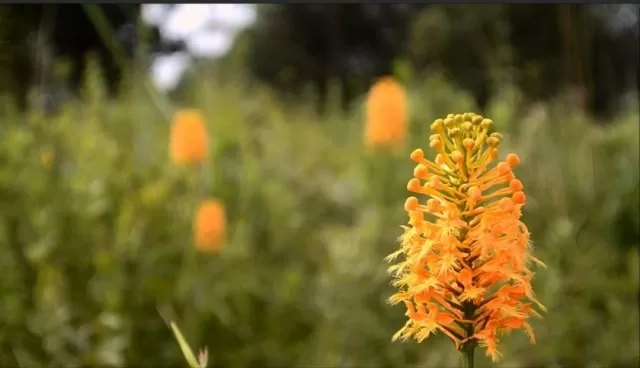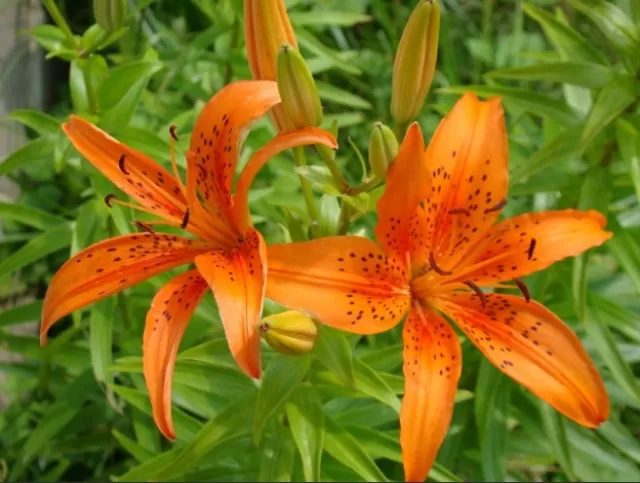10 Orange Flowers to Add Vibrancy to Your Garden (Part 2).If the color orange speaks to your soul, consider infusing your garden with its energetic presence. Orange flowers have the remarkable ability to punctuate all-white flower beds or harmoniously complement other bold and bright hues such as fuchsia and red. They serve as more than just a decorative element; orange blooms become a visual anchor, a focal point that highlights a specific area of your meticulously maintained landscape.
But the benefits of incorporating orange into your garden extend beyond aesthetics. By doing so, you’ll also delight pollinators, especially butterflies, who are particularly drawn to this vibrant hue, according to the National Wildlife Federation.
Eager to introduce these statement-making flowers to your outdoor haven? Garden experts Douglas Conley and Shannon Currey share some of their all-time favorite orange bloomers that are sure to add a burst of life and energy to your garden.
Exploring the Vibrant Beauty of the Orange Fringed Orchid

The Orange Fringed Orchid, scientifically known as Platanthera ciliaris, is a botanical wonder native to select regions of Canada, the Eastern United States, and the Southern United States.
Thriving in the unique habitat of peaty bogs and tranquil meadows, this orchid graces its environment with a burst of vibrant orange hues. Its exquisite orange flowers come to life for approximately a month during the late summer, creating clusters of delicate tangerine blossoms that possess an almost whimsical quality, thanks to their slender, whisker-like lower petals.
To successfully cultivate the Orange Fringed Orchid, a specific set of site conditions are essential.
Acidic soil and a boggy, watery locale, such as a pond or stream, are prerequisites for this charming orchid to thrive. While not everyone may have access to the ideal site conditions, it’s worth considering if your garden aligns with its preferences.
As horticulture enthusiast Conley mentions, the Orange Fringed Orchid may not be suitable for all gardeners due to its specific needs, but its presence can be appreciated across a relatively wide range, stretching from the Canadian province of Ontario down to the sunny state of Florida.
So, if you find yourself in an area where these conditions are met, the Orange Fringed Orchid promises to be a delightful and vibrant addition to your natural surroundings, offering a touch of wild beauty to your landscape.
\”Pyromania Orange Blaze\”: Setting Your Garden Ablaze with Irresistible Soda-Pop Orange
If you’re on the hunt for the most mouthwatering shade of soda-pop orange to ignite your garden’s color palette, look no further than Kniphofia pyromania, affectionately known as “Pyromania Orange Blaze.
” This fiery addition to your landscape is a showstopper, boasting a vibrant hue that can only be likened to the juiciest orange soda you’ve ever laid eyes on.
But “Pyromania Orange Blaze” doesn’t just dazzle with its striking color; it also features soft, grass-like foliage that adds a touch of elegance to your outdoor space.
In the company of plants like Liriope, which shares a similar foliage shape, this Kniphofia variety forms a harmonious partnership. Picture the contrast: “Pyromania Orange Blaze” with its blazing orange spikes and Liriope with its cool, spiky lavender blooms.
Together, they create a dynamic and visually arresting composition in your garden.
As gardening expert Conley suggests, these two plants make excellent companions, not only for their aesthetic qualities but also for the interesting textural interplay they bring to the garden.
So, if you’re ready to infuse your outdoor space with a burst of captivating color and intriguing foliage, “Pyromania Orange Blaze” is your ticket to setting your garden ablaze with irresistible charm.
Tiger Lily: The Exotic Marvel that Adorns Martha\’s Estate in Katonah, New York

Once a year, as mid-summer transitions into late summer, a breathtaking spectacle unfolds at Martha’s estate in Katonah, New York.
Along a meandering pergola near the Tenant House guest cottage, a vibrant congregation of Lilium lancifolium, more commonly known as Tiger Lilies, bursts into bloom. These graceful plants, with their characteristic freckled petals and striking orange hue, grace the estate with their profuse display.
What makes Tiger Lilies even more captivating is their remarkable ability to produce an abundance of blooms, often adorning each stem with up to 10 enchanting flowers.
This prolific nature adds to the allure of these exotic-looking perennials.
Gardening enthusiast Conley shares in the admiration for these hardy beauties.
He notes that they have a special place on the estate, particularly one situated just outside the courtyard at the main entrance to the house. Here, the anticipation builds as the season progresses, culminating in the glorious arrival of Tiger Lilies, marking a vibrant and eagerly awaited moment in the estate’s floral calendar.
Tiger Lilies, with their exotic appearance and annual spectacle of color, continue to enchant both Martha’s estate and garden lovers alike, reminding us of the enduring beauty found in nature’s treasures.
Trumpet Honeysuckle: Nature\’s Symphony of Coral-Orange Delight
In the world of gardening and wildlife, the coral-orange blooms of Lonireca sempervirens “Magnifica,” better known as Trumpet Honeysuckle, are a magnet for birds, bees, and hummingbirds alike.
Gardening expert Conley enthusiastically explains that this native honeysuckle species not only offers a visual feast of color but also serves as a bountiful source of nectar and joy for the local wildlife community.
What sets Trumpet Honeysuckle apart from its invasive cousin, Lonicera Japonica, is its low-maintenance nature.
While it can tolerate pruning, it doesn’t demand it, making it a more harmonious addition to your garden. This feature allows it to flourish without posing the invasive tendencies that some other honeysuckle varieties do.
For those fortunate enough to possess a trellis or an arbor in their garden, Trumpet Honeysuckle offers a delightful opportunity.
Pair it with a clematis, and you’ll create a captivating interplay of colors and blooming times. This harmonious coexistence not only elevates the visual appeal of your garden but also extends the duration of its natural beauty.
So, if you’re seeking to attract and support a diverse array of wildlife while enhancing the aesthetic charm of your outdoor space, Trumpet Honeysuckle stands ready as a vibrant and welcoming addition to your garden, promising a symphony of coral-orange delight.
Turk\’s Cap Lily: Nature\’s Mountain Masterpiece

In the rugged mountains of North Carolina, a few hours’ drive from Durham, the enchanting Lilium superbum, known as the Turk’s Cap Lily, graces the wilderness with its breathtaking presence.
This native lily species, which thrives in its wild habitat, captivates onlookers with its dramatic and almost otherworldly appearance. Its resemblance to Oriental or Asiatic lilies is striking, featuring multiple blooms that dangle gracefully upside down, as if defying the laws of gravity.
As one observer aptly describes it, the Turk’s Cap Lily often appears so surreal that it’s almost as if it exists in a realm of its own.
Bringing this natural wonder into your home garden can be a transformative experience.
The Turk’s Cap Lily not only serves as a magnificent focal point, drawing all eyes toward its captivating display but also acts as a vital food source for pollinators. Its presence attracts and nourishes a variety of bees, butterflies, and other essential insects, contributing to the overall health and biodiversity of your garden ecosystem.
Incorporating the Turk’s Cap Lily into your garden is like inviting a piece of North Carolina’s mountain beauty into your own backyard.
Its striking allure and ecological significance make it a treasured addition that brings the magic of the wilderness closer to home.
*The information is for reference only.